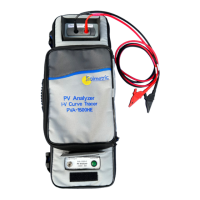Measuring Irradiance, Temperature, and Tilt
6-101
Determining Irradiance from the Measured I-V Curve
When you select the From I-V option, the PVA software calculates irradiance from the measured I-V
curve. This option has several benefits and limitations.
The From I-V option provides several benefits:
• There is no time delay between measurement of the I-V curve and determination of
irradiance. This is helpful when irradiance is changing rapidly (ramping) due to moving
clouds, a condition under which any time delay between I-V and irradiance
measurements translates into irradiance error.
• It is useful when measuring cell technologies that have a poor spectral match to the
SolSensor silicon irradiance sensor.
• Since the predicted Isc value is forced to agree with the measured Isc value, it is easy to
notice any deviations between the shapes of the measured and predicted I-V curves.
The From I-V irradiance option also has certain limitations:
• Uniform soiling is interpreted as reduced irradiance and thus does not cause a deviation
between the measured and predicted I-V curves. You can mitigate this risk by inspecting
the array before measuring, and cleaning it if needed.
• Similarly, uniform degradation of module Isc is also interpreted as reduced irradiance,
and thus is not detected. The From I-V temperature option provides several benefits:
• The From I-V irradiance value is used by the predictive PV model to calculate the
expected value of Isc. Using a measured value to calculate the expected value is circular,
forcing the expected value of Isc to agree with the measured value.

